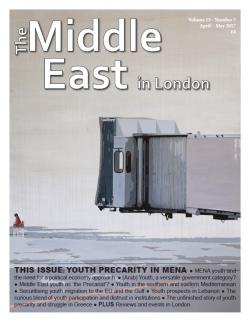Youth Precarity in MENA
Today, precariousness seems to be the leitmotiv of life for young people in the Middle East and North Africa. This precariousness is experienced differently depending on a young person’s social class, gender, place of residence, citizenship status, etc., but overall the current generation is faced with a much more difficult transition into adult life than their predecessors due to a variety of factors: insecure and low quality jobs or unemployment, constrained mobility, delays and difficulties in forming a family, finding a house and becoming independent. Underwriting all of this is a general uncertainty about the future. This special issue of The Middle East in London focusses on different aspects of youth precariousness (or precarity) in MENA – from employment problems to migration to recent forms of youth activism – drawing from the results of a three-year-long research project, POWER2YOUTH, funded by the European Union’s Seventh Framework Program and coordinated by the Istituto Affari Internazionali (IAI) of Rome. The project, carried out by a consortium of some 12 EU and south-east Mediterranean academic institutions including SOAS, sought to offer a critical understanding of youth in the south-east Mediterranean region through a comprehensive interdisciplinary and multi-level approach. In Insight, we call for a political economy approach when dealing with youth and youth problems, whilst Myriam Catusse and Blandine Destremau analyse the varying definitions of ‘the Youth’ that actually seem to institute the youth across a series of divides (class, gender, etc.), thereby giving rise to a conception that favours governing parts of them deemed dangerous. Linda Herrera (taking up the work of Guy Standing) argues that the youth of today are the new ‘Precariat’, and she criticises market-oriented policies that overstate the value of self-employment and entrepreneurship among the youth. Jon Pedersen and Åge A. Tiltnes present some of the results of the POWER2YOUTH youth-survey (carried out in Morocco, Tunisia, Egypt, the Occupied Palestinian Territories, Lebanon and Turkey) on issues of informality and precariousness. Françoise De Bel-Air looks at the securitisation of youth migration by the EU and Gulf countries. Mona Harb describes the situation of Lebanon’s youth: trapped in a political system sealed by hegemonic political-sectarian parties. Amid this bleak picture, she finds some tenuous hope in recent youth initiatives. Nadine Sika reports on a summary of her empirical research that shows general youth distrust in political institutions has developed into new and unconventional forms of political participation in the region. Finally, the issue concludes with Maria M. Mexi’s analysis of the youth struggle in Greece, part of POWER2YOUTH’s comparative effort that reaches outside of MENA, underlining the similarities of youth conditions and struggles in MENA and southern European countries.
-
Details
in The Middle East in London, Vol. 13, No. 3 (April–May 2017), p. 3-20 -
ISBN/ISSN/DOI:
1743-7598
Editorial, Maria Cristina Paciello and Daniela Pioppi, p. 4
Insight
MENA youth and the need for a political economy approach, Maria Cristina Paciello and Daniela Pioppi, p. 5-6
Youth Precarity in MENA
(Arab) Youth, a versatile government category?, Myriam Catusse and Blandine Destremau, p. 7-8
Middle East youth as ‘the Precariat’?, Linda Herrera, p. 9-10
Youth in the southern and eastern Mediterranean: between informality and precariousness, Jon Pedersen and Åge A. Tiltnes, p. 11-12
Securitising youth migration to the EU and the Gulf: a time bomb?, Françoise De Bel Air, p. 13-14
Youth prospects in Lebanon: tenuous possibilities amidst a bleak reality, Mona Harb, p. 15-16
The curious blend of youth participation and distrust in institutions, Nadine Sika, p. 17-18
The unfinished story of youth precarity and struggle in Greece, Maria M. Mexi, p. 19-20
Topic
Tag
Related content
-
Ricerca08/10/2014
POWER2YOUTH - Freedom, dignity and justice
leggi tutto



